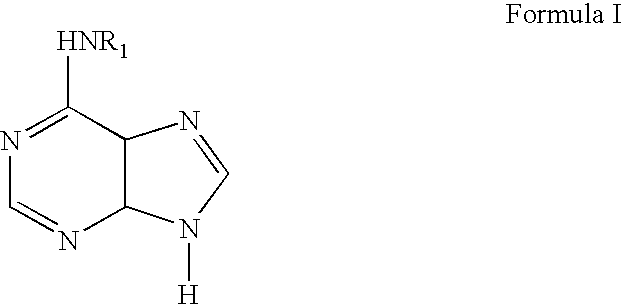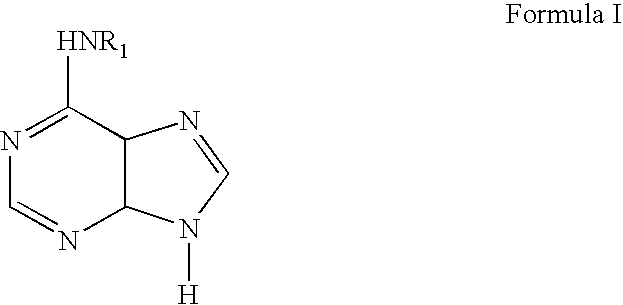Methods for altering mRNA splicing and treating familial dysautonomia and other mechanistically related disorders
a technology of familial dysautonomia and mrna splicing, which is applied in the field of altering the splicing of mrna in cells, can solve the problems of tissue-specific decrease in the splicing efficiency of the mutant ikbkap allele, marked reduction of quality of life and premature death, and reduced splicing efficiency of the ikbkap allele. , to achieve the effect of reducing the missplicing of th
- Summary
- Abstract
- Description
- Claims
- Application Information
AI Technical Summary
Benefits of technology
Problems solved by technology
Method used
Image
Examples
example 1
IKBKAP mRNA Ratio Analysis
[0085] An assay that provides stable and consistent measurement of the ratio of WT:MU FD IKBKAP mRNA splice products in lymphoblast cell lines was developed4. This assay was employed as part of the Neurodegeneration Drug Screening Consortium7 to identify compounds that increase the relative production of WT mRNA. A single, standard FD lymphoblast cell line was assayed after 72 hours in the presence of 10 μM test drug, using compounds dissolved in DMSO. A panel of 1040 bioactive compounds (NINDS Custom Collection, MicroSource Discovery Systems) were screened, most of which have been approved for use by the Food and Drug Administration (FDA). Prior to initiating the screen, it was confirmed that DMSO had no effect on IKBKAP splicing and was not toxic to the cells at the test concentration of 0.1%. One compound, kinetin (6-furfurylaminopurine) (FIG. 1b), dramatically enhanced correct splicing in FD cells at the test concentration of 10 μM (FIG. 1c).
[0086] Co...
example 2
MYO5A mRNA Ratio Analysis
[0088] To explore whether the effect of kinetin was specific to IKBKAP exon 20 or generally increased inclusion of alternatively spliced exons, splicing of the MYO5A gene was assayed (FIG. 3a). MYO5A expresses multiple isoforms in fibroblasts and lymphoblasts, one of which is generated by skipping of exon 3110. Primers flanking exon 31 were designed. The ratio of the two MYO5A isoforms in nine FD lymphoblast cell lines following treatment with 50 μM kinetin for 72 hours was examined. No significant difference was observed in the ratio of the two isoforms between the treated and untreated samples, with average transcript ratios of 2.33 and 2.46, respectively (FIG. 3b).
example 3
IKBKAP Nonsense Mediated Decay Analysis
[0089] The IVS20+6T→C mutation in IKBKAP leads to a frameshift and a premature termination codon in exon 21, which is expected to target the mutant transcript for decay via the nonsense-mediated mRNA decay (NMD) pathway15. To exclude the possibility that the observed changes in the WT:MU transcript ratio in the presence of kinetin were due to increased NMD of the mutant transcript rather than direct action of kinetin on IKBKAP splicing, the WT:MU transcript ratio was assayed in the absence of NMD. FD cells were exposed to cycloheximide, a translation inhibitor, to inhibit NMD of the mutant transcript16. FD cells treated with cyclohexamide alone increased mutant transcript levels thereby decreasing the WT:MU transcript ratio as expected (FIG. 4). However, FD cells treated kinetin in the presence of cycloheximide significantly altered the WT:MU transcript ratio in a manner similar to that of kinetin treatment alone (FIG. 4). Thus, the observed d...
PUM
| Property | Measurement | Unit |
|---|---|---|
| concentration | aaaaa | aaaaa |
| concentration | aaaaa | aaaaa |
| concentration | aaaaa | aaaaa |
Abstract
Description
Claims
Application Information
 Login to View More
Login to View More - R&D
- Intellectual Property
- Life Sciences
- Materials
- Tech Scout
- Unparalleled Data Quality
- Higher Quality Content
- 60% Fewer Hallucinations
Browse by: Latest US Patents, China's latest patents, Technical Efficacy Thesaurus, Application Domain, Technology Topic, Popular Technical Reports.
© 2025 PatSnap. All rights reserved.Legal|Privacy policy|Modern Slavery Act Transparency Statement|Sitemap|About US| Contact US: help@patsnap.com



